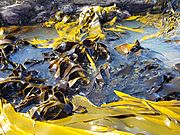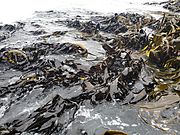Durvillaea willana facts for kids
Quick facts for kids Durvillaea willana |
|
|---|---|
 |
|
| D. willana at Watsons Beach, Otago, with the epiphyte Pyrophyllon subtumens growing on the middle plant | |
| Scientific classification |
Durvillaea willana is a very large type of bull kelp. It is a special kind of seaweed that grows only in New Zealand.
Contents
What's in a Name?
This amazing kelp was named willana to honor Eileen Alice Willa. She was a scientist who collected many different kinds of seaweed for another scientist named Lindauer.
Discovering Durvillaea willana
This kelp is easy to spot because it's a dark chocolate brown color. It's even darker than other types of bull kelp!
How It Looks
Durvillaea willana has a special stem, called a stipe, that branches out. Its long, flat parts, called fronds, do not have air pockets. This means they don't float. The part that holds the kelp to rocks, called the holdfast, grows very large. It spreads out like a plate on the rocky seafloor.
Comparing Bull Kelp Species
This kelp might look a bit like Durvillaea antarctica. However, D. willana has smaller fronds. It also usually grows lower down on the shoreline. This is because it can't handle strong waves as well as D. antarctica. Remember, D. willana has a branched stipe and fronds that don't float. D. antarctica is different in these ways.
- Images of Durvillaea willana
-
D. willana growing on Taieri Island, showing the distinctive branched stipe and dark colouration
Where Durvillaea willana Lives
This special kelp is found only in New Zealand. You can find it on the southeastern coasts of the North Island. It's not found in Cook Strait, though. It also grows along the shores of the South Island and Stewart Island.
Surviving Earthquakes
Sometimes, big events like earthquakes can lift parts of the land. This can change where sea creatures live. Scientists thought that past earthquakes might have created gaps in where D. willana grows. However, studies show that even very old earthquakes didn't cause big problems for this kelp. This suggests that D. willana living underwater might be tough enough to survive these natural events.





